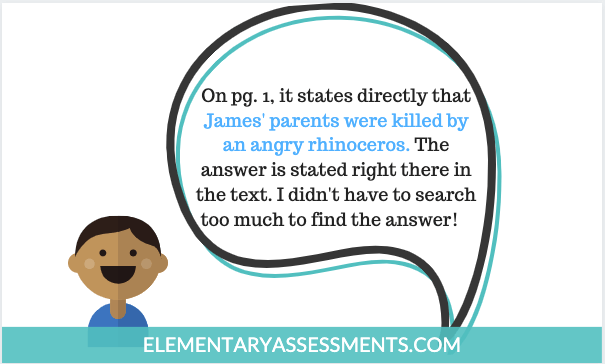Are you looking for a non-boring way to increase students’ reading comprehension and boost reading test scores?
If so, then the Prove It reading strategy is your answer.
The Prove It reading strategy encourages readers to refer back to the text they’re reading in order to find evidence that “proves”, or supports their responses.
This technique creates student accountability and motivates readers to “think and search” within a text.
Have you ever asked learners a comprehension question and received some bizarre answers?…
Looked on in amazement at a few of the responses they come up with that have nothing to do with the text at hand?
Or maybe they answer correctly but don’t really know how to explain very well the “why”.
You’ve probably left work many a days, scratching your head, thinking…

Implementing the Prove It Reading Strategy
1. Choose a Book.
Though you’ll only need to choose one text, the two examples within this article are… James and the Giant Peach (Roald Dahl) and What Was the Underground Railroad? (Yona Zeldis McDonough).
For the Prove It reading strategy to be most effective, students need a personal copy of the text.
A photocopied chapter or section of a book works fine if individual student copies of the book aren’t available.
Choose a book that aligns with what you’re teaching in class. Also, ensure the chosen book has sufficient information/enough words.
2. Create Leveled Questions and/or Statements.
Now that you’ve chosen a book, it’s time to write comprehension questions and statements. Ideally, these questions and statements are leveled.
The idea is that some questions are harder to answer than others.
Write a variety of statements/questions … some that learners will easily find the answers to and others that will require more searching and thinking.
Throw in a couple of questions that can’t be answered directly from the text; readers will have to rely on prior knowledge and personal experiences.
You don’t have to reinvent the wheel. Many of the texts you’re already using with students have accompanying questions and statements.
Simply tweak them for your needs.
Following are the questions and statements for the two book examples.
James and the Giant Peach (Chapter 1)
- What animal killed James’ parents?
- Define jiffy.
- Besides sad and lonely, how does James feel about living with his aunts?
- What is a nuisance?
- Name a simile from chapter 1.
- Describe James’ two aunts.
What was the Underground Railroad? (Chapter 5: The Great Conductor)
- Why was the route named the Underground Railroad?
- Define overseer.
- Why did Harriet decide to escape?
- Why wasn’t Harriet able to read or write?
3. Ask Students to “Prove” Their Responses.
Once students have had an opportunity to view the questions/statements and locate the answers, it’s now time for them to “prove” their responses with evidence from the book.
One by one, read each statement or question.
The first question:
“What animal killed James’ parents?”
Students volunteer to answer.
Choose one student or a group (if working in small groups). The chosen child responds…
After he/she answers, the class responds…

Students really enjoy saying (more like yelling!) “Prove It”, but you don’t have to do it like that. You yourself could simply ask the reader for his proof.
Now the child shares his proof.
Another example…
“Define jiffy.”
The children respond…

The reader provides evidence to support her response.
Here’s one more…
“Why was the route named the Underground Railroad?”
Students respond … “PROVE IT!”
The child provides proof to support his response…
Prove It Reading Strategy as a Test-Taking Technique
The Prove It reading strategy is powerful as a test-taking technique.
If possible, encourage students to “prove” their answers by underlining evidence in the test booklet.
They record somewhere near the test question corresponding page numbers where that evidence was found.
Prove It Reading Strategy Poster
To use this strategy to prepare students for standardized testing, provide a mini-poster to guide them in “proving” their answers.
Though the poster can’t be used during the actual state test, if you use it throughout the school year, learners will eventually memorize the steps.
Steps to follow…
- Preview the set of questions.
- Read the text carefully and at least twice.
- Omit answers that are the least best choice.
- Verify your answers with proof.
- Explain your answers to a group or partner using evidence (proof).
- Infer using prior knowledge and clues, if necessary.
- Test your answer. Ask yourself, “Does the answer make sense?“
Try the Prove It Reading Strategy
Prove It boosts students’ reading comprehension levels and consequently their test scores.
The strategy works equally well for whole group, small group, and one-on-one instruction, so pencil it into one of your reader’s workshop mini-lessons this week.






